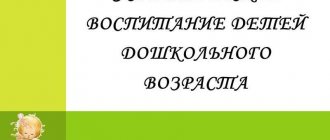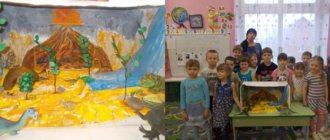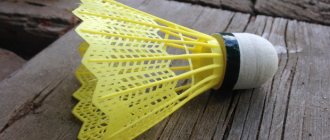Article on the topic “Project activities in preschool educational institutions as a tool for the practical implementation of the Federal State Educational Standard”
3) draw conclusions based on the results of the project.
The content of the work
aimed at studying and implementing the design method in preschool educational institutions.
Chapter I. _ Project method in the activities of preschool educational institutions
§1.1 The project method as a tool for the practical implementation of the Federal State Educational Standard
Today the state has set a task to prepare a completely new generation: active, inquisitive. And preschool institutions, as the first step in education, already have an idea of what a kindergarten graduate should be like, what qualities he should have.
In accordance with the requirements that modern life dictates to us and which are laid down in the Law of the Russian Federation “On Education” and the Federal State Educational Standard
, the educational institution is obliged:
- ensure individualization for each child;
— provide conditions for self-determination and self-realization of the individual;
- realize the child’s right to free choice of activities, opinions and
reasoning;
- remember that the child is an active participant in the pedagogical process;
- involve children in activities without psychological coercion, relying on
on their interest in the content and forms of activities, taking into account their
social experience;
— ensure emotional, personal and social and moral development
child, preserve and strengthen the health of children.
All these requirements can be realized only under one condition - to radically change the organization of the pedagogical process in preschool educational institutions, by choosing the most effective means of teaching and education, which requires the widespread introduction of innovative and alternative forms and methods of conducting educational activities into the pedagogical process.
In this regard, teachers of preschool institutions strive to find new, innovative, most effective ways and means of solving problems.
Today, one of the most vibrant, educational, interesting, and significant methods for both adults and preschool children is project activity.
. This is due to the fact that design in all spheres of human activity is becoming a universal tool that allows it to be systematic, goal-oriented and effective.
Project method
is a pedagogical technology, the core of which is the independent activity of children - research, cognitive, productive, in the process of which the child learns about the world around him and embodies new knowledge into real products.
“Everything that I learn, I know, why I need it and where and how I can apply this knowledge” - this is the main thesis of the modern understanding of the project method.
The basis of the project method
the idea is that the cognitive activity of preschoolers is focused on the result that is achieved in the process of joint work of the teacher, children and parents on a certain practical problem (topic). Solving a problem or working on a project in this case means applying the necessary knowledge and skills from various sections of the educational program for preschoolers and getting a tangible result.
“The project method as an innovative pedagogical technology in preschool education”
“The project method as an innovative pedagogical technology in preschool education”
Relevance of the
project
In accordance with the ever-increasing requirements that modern life dictates to us and which are laid down in the Law of the Russian Federation “On Education”, the national doctrine of education in the Russian Federation and the concept of modernization of Russian education, an educational institution (regardless of what programs it uses to build the educational process ) must:
●ensure individualization for each child;
●provide conditions for self-determination and self-realization of the individual;
●realize the child’s right to free choice of activities, opinions and thoughts;
●remember that the child is an active participant in the pedagogical process;
●involve children in activities without psychological coercion, based on their interest in the content and forms of activity, taking into account their social experience;
●to ensure the emotional, personal and social-moral development of the child, to preserve and strengthen the health of children.
Therefore, Russian preschool educational institutions are actively restructuring their own work in accordance with the new regulatory document - the Federal State Educational Standards for Preschool Education (FSES).
In this regard, the task before us, educators, is to educate an individual who is able to integrate into society, behave positively in it, think independently, obtain and apply knowledge, think and make independent decisions. After all, modern children should know and be able to do a lot more than their peers 15-20 years ago, so teachers’ constant concern is choosing the most effective means of teaching and education.
All these requirements can be realized only under one condition - to change the organization of the pedagogical process in preschool educational institutions, by choosing the most effective means of teaching and education, which requires the widespread introduction of innovative and alternative forms and methods of conducting educational activities into the pedagogical process. Traditional education is being replaced by productive learning, which is aimed at developing creative abilities, developing preschoolers' interest and need for active creative activity. One of the promising methods to help solve this problem is the project method
.
What is a project?
The term “project” was borrowed from classical Latin, in which it originally meant “thrown forward,” “protruding,” “conspicuous.”
According to the definition of the American educator, the founder of the project method, William Hurd Kilpatrick, a project
- this is any action performed with all the heart and with a specific purpose.
What is the project method?
Project method
– pedagogical technology aimed at teaching children project activities.
Project activities
individual and collective subject - this is (respectively) individual or group (collective) activity aimed at achieving a set goal - solving a specific problem that is significant for the participants in the project activity and formalized in the form of a certain final product.
Project method
is a pedagogical technology, the core of which is the independent activity of children - research, cognitive, productive, in the process of which the child learns about the world around him and embodies new knowledge into real products.
The essence of the project method
in education consists of such an organization of the educational process in which students acquire knowledge and skills, experience in creative activity, an emotional and value-based attitude to reality in the process of planning and performing gradually more complex practical tasks of projects that have not only cognitive, but also pragmatic value.
The project is a model of three questions:
What do we know?
What do we want to know?
What do you need to do to find out?
“Everything I learn, I know why I need it and where and how I can apply this knowledge” - this is the main thesis of the modern understanding of the project method. In other words, the project method is based on the idea of focusing the cognitive activity of preschoolers on the result that is achieved in the process of joint work between the teacher and children on a specific practical problem (topic).
The knowledge acquired by children during the project becomes the property of their personal experience. They were obtained in response to questions posed by the children themselves in the process of “doing.” Moreover, the need for this knowledge is dictated by the content of the activity. Children need them and therefore are interesting to them. After all, from birth, a child is a discoverer, an explorer of the world that surrounds him. Everything is a first for him. Everyone knows that children are called “why”. A child cannot find the answer to all his questions on his own; teachers and parents help him.
Why is the project method needed?
It is one of the methods of developmental education, since it is based on the development of children’s cognitive interests.
It is projects that are able to link the not-so-fun educational process with real events that happen from time to time in a child’s life, which attracts and can interest even the most restless child.
Allows you to develop a system of productive interaction between project participants.
Project activities in preschool educational institutions allow you to turn any team into a cohesive team, whose members will be able to work together to solve even the most complex and non-trivial problems. In such conditions, every child can feel needed and interested in performing an important task.
The child’s subjective position is formed, his individuality, creative abilities, and logical thinking are revealed.
The teacher's competence increases.
Project classification:
Currently, projects can be classified according to the following criteria:
a) by composition of participants:
group, subgroup, personal, family, couples, etc.
c) the dominant type of activity in the project:
—informational and social
. During the implementation of this project, children collect and study information from books, the Internet, magazines and other sources. Designed in the form of a video, newspaper, or folding folder. For example "My pet"
—practice-oriented
or regulatory projects. During this project, a set of rules is created that are used in the activity. The results are presented in the form of an album, a memo, drawings, and a model. For example, "Road ABC".
—creative projects
. Children master various types of creative activities. The design takes place in the form of a holiday, concert, design, album, exhibition, dramatization. For example, "Autumn Fantasies"
—research projects
. Children get an answer to the question of why this or that phenomenon exists and how it is explained. The results are presented in the form of newspapers, albums, diagrams, models. For example, “What kind of water is there?”
—game projects
. Children take on the role of a character and solve problems in a playful way.
The development and implementation of such a project is the most difficult. By participating in it, designers take on the roles of literary or historical characters, fictional heroes in order to recreate various social or business relationships through game situations. The result of the project remains open until the very end. An example is a role-playing game.
d) by the nature of contacts:
carried out within one age group, in contact with another age group, within a preschool educational institution, in contact with family, cultural institutions, public organizations (open project);
e) by implementation time:
- short-term (one or several lessons - 1-2 weeks);
- average duration (2-3 months);
- long-term (for the academic year).
Stages of work on the project:
Stage I - goal setting, problem
Planning any project activity must necessarily begin with discussion and reflection on the following questions: “Why is this work needed at all?”, “Why is it worth doing?”, “What will happen to the final result of the work after completion of the work?”, “In in what form should the product be sold?
A problem is brought up for consideration and discussion by children, which is proposed to be resolved as a result of joint activity, or a hypothesis is put forward that needs to be confirmed.
Stage II - development of a joint plan to achieve the goal
(the hypothesis is the goal of the project)
It turns out that the children already know about the topic of the project. What do they want to know? How to find answers to your questions. Based on the results obtained, forms of work are planned that will allow us to resolve the questions raised: reading books, observing, contacting parents, experiments, excursions, experiments, etc.
Stage III - search and accumulation of material
Searching for information, sources of information, surveys, contacting specialists, parents, equipment and materials to work with.
Stage IV - practical, project implementation
It is important to remember that design and research activities in preschool educational institutions should actively use not only the creative method of cognition. Experiments, practical tasks, problem situations, practically useful things are very important, during which the child gains invaluable experience that will be useful to him in later life.
In general, the uniqueness of the project method lies in the fact that it promotes the diversified development of the student’s personality: the child becomes an integral, comprehensively developed personality with well-developed self-esteem and the ability to be responsible for all his actions.
Stage V – presentation
The project activity ends with the organization of a presentation on the topic covered. During this event, the creative potential of each preschooler is perfectly revealed, and all the information that the children received while working on the project finds practical application.
The presentation can take different forms, but the results must be visible:
exhibitions, albums, newspapers, mini-museums, photo exhibitions, collections, holidays, videos, etc.
It’s easy to remember the stages of the project: these are the five Ps, the five fingers on your hand:
1.Problem
2.Planning
3.Search for material
4.Practical implementation
5.Presentation
But in fact, every teacher organizing a project in a preschool educational institution should have the sixth “P” of the project - this is his Portfolio, i.e. a folder in which all working materials are collected, including drafts, daily plans, notes and other teaching materials used during project activities.
Features of organizing project activities with preschoolers:
Necessary has its own specifics when applied in preschool education. This is due to the age characteristics of preschool children, which must be taken into account.
A preschooler cannot independently determine a goal or plan, or identify a problem, so project activities in a preschool educational institution are in the nature of cooperation, in which children, teachers and even parents participate, who can become full participants in the project. In most cases, the child has to be “guided”, helped to detect the problem, and in some cases, directly contribute to its occurrence. It is important to try to “draw” the children into a joint project, but it is extremely important in this case not to overdo it with guardianship.
Children 3-5 years old:
At this stage, children participate in the project “in a secondary role”, perform actions at the direct suggestion of an adult or by imitating him, which does not contradict the nature of a small child. At this age, there is still a need to establish and maintain a positive attitude towards an adult and imitate him.
Children 5-6 years old:
By this age, children already have experience in a variety of joint activities, can coordinate actions, and help each other. The child is less likely to turn to adults with requests and is more actively organizing joint activities with peers. Children develop self-control and self-esteem, they are able to fairly objectively evaluate both their own actions and the actions of their peers. At this age, children accept the problem, clarify the goal, and are able to choose the necessary means to achieve the result of the activity. They not only show a willingness to participate in projects proposed by adults, but also find problems on their own.
Children 6–7 years old:
The share of children's independent activities is increasing significantly. At this stage, it is very important for an adult to develop and support the creative activity of children, to create conditions for children to independently determine the purpose and content of the upcoming activity, to choose ways to work on a project and the opportunity to organize it.
Types of teacher activities within the framework of the “Project Method” technology:
Within the framework of the “Project Method” technology, the following types of teacher activities are possible:
●the teacher sets a goal based on the needs and interests of the child (children);
●involves preschoolers in problem solving;
●outlines a plan for moving towards the goal (together with children and (or) parents, maintains the interest of children and parents);
●discusses the project implementation plan at a parent meeting (if the project is labor intensive);
●seeks recommendations from preschool education specialists;
●works together with children and parents to plan the project;
●collects information, material;
●organizes classes, games, observations, excursions (events of the main part of the project),
●offers tasks for parents and children to work independently;
●encourages independent creative work by children and parents (searching for materials, information, making crafts, drawings, albums, etc.);
●organizes a presentation of the project (holiday, activity, leisure), compiles a book, album together with children;
●sums up the results (speaks at the teachers' meeting, summarizes work experience);
●consults project participants at all stages of its implementation.
An approximate structure for teachers to prepare a report on a project carried out at a preschool educational institution
Title page - project name, project type, project time frame, project author.
The topic of the project and its origin, relevance.
The purpose and objectives of the project.
System web for the project.
All types of children's activities and forms of joint activities during the project are listed. All of them are distributed according to educational areas, clause 2.6. GEF DO:
social and communicative development;
cognitive development;
speech development;
artistic and aesthetic development;
physical development.
Also, the system web indicates forms of interaction with family and social partners during project activities, forms of joint activities within the project during sensitive moments.
Expected results of the project: for children, for teachers, for family members.
Brief summary of the project: for all stages completed.
Project product description: for children, for teachers, for parents.
Presentation of the project - demonstration of the project products to others (it is appropriate to place photographs of the project product).
Reflection of a teacher using the “Project Method” technology
Preschool teachers who use the project method in their professional activities note the following:
“The project method is one of the methods of integrated teaching for preschoolers, which is based on the interests of children.”
“In the process of project activities, children’s independent activity increased.”
“Acting independently, children learned in different ways to find information about objects and phenomena that interested them, and used their knowledge to create new objects of activity.”
“Project activities contributed to the formation of independence and deeply motivated cognitive activity in children.”
“Project activity is one of the leading ones in achieving educational results.”
“Children become more emotional, their vocabulary is activated, and their imagination develops.”
“Children get pleasure from the result of the work done.”
Conclusions:
Thus, during the implementation of the project, each child develops a certain position on a specific issue. Children get the opportunity to reveal their creative potential and show everyone their individuality.
The project method affects not only the intellectual side of development, but also feelings, emotions, and attitude towards the world around us. Children can freely think and express their opinions, and, most importantly, act. And active activity is the most effective type of information perception.
All this has an extremely beneficial effect on the development of the child’s personality, contributes to the formation of normal self-esteem, and ideally prepares preschoolers for their further education and for life in general.
The project method allows you to move from traditional, relay, knowledge transfer to active learning methods.
A Chinese proverb says:
“
Tell me and I will forget, show me and I will remember, let me try and I will understand.”
These words very succinctly reflect the essence of the project method.
Informational resources:
Literature
Bliznetsova V.S. Management of project activities of preschool teachers // Directory of a senior teacher of a preschool institution, 2009, No. 9.
Veraksa N. E., Veraksa A. N. Project activities of preschoolers. A manual for teachers of preschool institutions. - M.: Mosaic - Synthesis, 2008. - 112 p.
Evdokimova E. S. Project as motivation for knowledge // Preschool education. - 2003. - No. 3.
Morozova L.D. Pedagogical design in preschool educational institutions; from theory to practice. Supplement to the magazine "Preschool Education Management". Sphere, -2010.
Khabarova T.V. Pedagogical technologies in preschool education. Saint Petersburg. Childhood-Press. 2011.
Shtanko I.V. Project activities with children of senior preschool age. Journal "Management of a preschool educational institution", 2004, No. 4.
Internet sources
https://dohcolonoc.ru/proektnaya-deyatelnost-v-detskom-sadu.html
8
On the use of design technology in teaching preschoolers
Prokofieva Evgenia Borisovna
teacher of MBDOU "Gorodishche kindergarten" Scarlet Flower "Stary Oskol city district
Today, the state has set a new task - to prepare a completely new generation: active, inquisitive. And preschool institutions, as the first step in education, already have an idea of what a kindergarten graduate should be like, what qualities he should have.
Project activity is a joint gaming or creative activity. It develops independence, responsibility, initiative, and determination.
The goal of project activities in preschool educational institutions is the development of the child’s free creative personality, which is determined by the developmental tasks and tasks of the children’s research activities.
Development objectives:
- Ensuring the psychological well-being and health of children.
- Development of cognitive abilities,
- Development of creative imagination.
- Development of creative thinking.
- Development of communication skills.
Advertising message
The use of innovative pedagogical technologies opens up new opportunities for the education and training of preschoolers, and the project method has become one of the most effective today. Using the project method in preschool education as one of the methods of integrated teaching of preschoolers can significantly increase children's independent activity, develop creative thinking, children's ability to independently find information about an object or phenomenon of interest in different ways and use this knowledge to create new objects of reality.
The objectives of research activities are specific for each age
In early preschool age this is:
- children’s entry into a problematic play situation (the leading role of the teacher);
- activating the desire to look for ways to resolve a problem situation (together with the teacher);
- formation of initial prerequisites for research activities (practical experiments).
In older preschool age this is:
- formation of prerequisites for search activity and intellectual initiative;
- developing the ability to identify possible methods of solving a problem with the help of an adult, and then independently;
- developing the ability to apply these methods to help solve the problem, using various options;
- developing a desire to use special terms, conducting a constructive conversation in the process of joint research activities.
- Choosing a topic is the teacher’s first step in working on a project.
2. The second step is thematic planning on the selected problem for the week, which takes into account all types of children's activities: play, cognitive-practical, artistic-speech, work, communication, etc. At the stage of developing the content of classes, games, walks, observations and other activities related to the theme of the project, educators pay special attention to organizing the environment in groups and in the preschool institution as a whole. The environment should be a backdrop for heuristic, search activities and develop curiosity in a preschooler. When the basic conditions for working on the project have been prepared (planning, environment), the joint work of the teacher and children begins.
Stage I of project development - goal setting: the teacher brings the problem to the children for discussion. As a result of a joint discussion, a hypothesis is put forward, which the teacher invites the children to confirm in the process of search activity.
Stage II of work on the project is the development of a joint action plan to achieve the goal (and the hypothesis is the goal of the project). First, a general discussion is held so that the children find out what they already know about a certain subject or phenomenon. The teacher records the answers on a large piece of Whatman paper so that the group can see them. To record answers, it is better to use conventional schematic symbols that are familiar and accessible to children. Then the teacher asks the second question: “What do we want to know?” The answers are again recorded, regardless of the fact that they may seem stupid or illogical. It is important here that the teacher shows patience, respect for the point of view of each child, and tactfulness in relation to the ridiculous statements of the kids. When all the children have spoken, the teacher asks: “How can we find answers to the questions?” When answering this question, children rely on their personal experience. It is also necessary to take into account the age characteristics of the students. For children of primary preschool age, the teacher can use hints and leading questions; for children of older preschool age it is necessary to provide more independence. The solution to this question can be various activities: reading books, encyclopedias, contacting parents, specialists, conducting experiments, thematic excursions. The proposals received are additions and changes to the teacher’s already prepared thematic plan. It is important that the teacher shows flexibility in planning, manages to subordinate his plan to the interests and opinions of children, including children's activities in the curriculum, sacrificing some planned forms of work. This skill is an indicator of the high professional skill of the educator, his willingness to deviate from existing stereotypes, putting first the intrinsic value of preschool childhood as a period of life and only then as a preparatory stage for the future.
After drawing up a joint action plan, the third stage of work on the project begins - its practical part. Children explore, experiment, search, create. To activate children's thinking, the teacher offers to solve problem situations and puzzles, thereby developing an inquisitive mind. It is necessary that the teacher be able to create a situation where the child must learn something on his own, guess, try, invent something. The environment around the child should be, as it were, unfinished, unfinished. A special role in this case is played by corners on cognitive and practical activities.
The final IV stage of work on the project is the presentation of the project. The presentation can take place in various forms, depending on the age of the children and the topic of the project: final games-activities, quiz games, themed entertainment, design of albums, photo exhibitions, mini-museums, creative newspapers. Projects, regardless of type, creative, research, informational, open, playful, practice-oriented, etc., require constant attention, help and accompaniment from adults at every stage of implementation.
The specificity of using the project method in preschool practice is that adults need to “guide” the child, help with parental care and assistance.
The topic of projects can be a specific section of the educational program. But if the topic arose on the initiative of children, this is very valuable and should find support from adults.
Currently projects are classified:
- – according to the composition of participants;
- – according to the target setting;
- - by topic;
- - according to implementation deadlines.
The following types of projects are used in the practice of modern preschool institutions:
research and creative projects: children experiment, and then the results are presented in the form of newspapers, dramatization, children's design;
role-playing projects (with elements of creative games, when children take on the role of fairy tale characters and solve problems in their own way);
information-practice-oriented projects : children collect information and implement it, focusing on social interests (design and design of the group, stained glass windows, etc.);
creative projects in kindergarten (registration of the result in the form of a children's party, children's design)
In terms of duration, they can be short-term (one or several classes), medium-long, or long-term.
Project activity is project only if direct action in a particular situation is impossible. In other words, if a child wanted to play with a ball, took the ball for this, and carried out his plan, or if the instructor organized and conducted physical education leisure, then this activity will not be a project activity - the child and the teacher performed all the actions within the framework of traditional productive and educational activities. And if, before spending leisure time at the Olympic Games, the teacher, together with the children, comes to a decision during a discussion about the need to hold such a holiday, then plans the paths leading to achieving this goal. Children, together with their parents and teachers, spend several weeks selecting, studying and presenting information about Olympic sports, competition rules, records and winners, making attributes, learning the rules, watching and discussing presentations and video clips, and developing sports skills. And the result of this activity is the sports festival “Small Olympic Games” with the involvement of parents, an exhibition of photographs, etc. is a long-term project.
Children participating in project activities:
- show creative activity in understanding the world around them;
- independent in decision making;
- consciously use sensory sensations in solving practical problems;
- realize themselves as a subject who understands (what is known, what is not, how one can find out);
- are able to discuss a joint action plan in a children's group;
- perceive the natural world not only from a utilitarian point of view, but also realize its uniqueness, beauty, and universality.
Teachers who use the project method in their activities:
- demonstrate the ability to independently creatively plan the entire educational process;
- have the ability to take a flexible approach to planning, taking into account the interests and needs of children;
- carry out search pedagogical activities;
- realize their creative skills (in visual, literary, musical activities).
Design changes the role of educators in managing the pedagogical process of preschool educational institutions; they act as active participants, and not executors of the will of certain specialists. Activities in creative groups help to learn how to work in a team, and develop your own analytical view of the practice of raising and teaching children. Educators are free to choose methods and types of activities to achieve their goals; no one imposes their point of view on them. Even an unsuccessful project contributes to the development of professionalism. Understanding mistakes creates motivation for repeated activities and encourages self-education. The ability to use the project method is an indicator of the teacher’s high qualifications, his mastery of progressive methods of teaching and developing children.
Parents taking part in the project activities of the preschool institution:
- - establish close contact not only with their child, but also with the team of parents and children of the group;
- - get the opportunity not only to learn about what the child is doing in kindergarten, but also to take an active part in the life of the group;
- - can realize their creative abilities.
Undoubtedly, the proposed technology is not universal. But all the diverse technologies should form the child’s main need - self-development as a natural state.
The use of the project method is an indicator of the teacher’s high qualifications and his progressive methods of teaching and developing children. It is not for nothing that these technologies are classified as technologies of the 21st century, which provide, first of all, the ability to adapt to the rapidly changing conditions of human life. Intensive changes in the surrounding life, the active penetration of scientific and technological progress into all its spheres dictate to the teacher the need to choose more effective means of teaching and education based on integrated technologies, which is the project method. It is aimed at developing the child’s personality, his cognitive and creative abilities.
In the created subject-spatial developmental environment, children actively develop and establish information about the world around them during games and other types of children's activities. The developing subject-spatial environment is aimed at the development of cognitive qualities, and social interaction, at the formation of psychological qualities of research activity, while preserving the individuality of each child.






